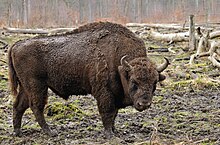Wisent Monument (Bremen)
The bison monument in the Rhododendron Park in Bremen's district of Horn-Lehe was erected there in 1940 and is in the list of monuments and statues of the City of Bremen performed.
monument
The 2.30 m high bronze bison was made in 1935 by Heinze & Barth's foundry based on a model created in the Berlin studio of the sculptor Ernst Gorsemann . In the same year it was given a prominent place in front of the Berlin Künstlerhaus on Tiergartenstrasse. Both the presentation there and even more the prominent exhibition of the sculpture on the roof of the German pavilion at the Paris World Exhibition in 1937 illustrates the appreciation of the artist and his work by the National Socialist art policy. But the organizers also honored Gorsemann with a gold medal.
The bison has been a popular motif in national iconography since the German Empire, and even more so in the Third Reich: 17 specimens were counted at the Great German Art Exhibitions from 1937 to 1944 . The forest cattle, which was closely associated with the Germanic times, stood as a metaphor for the superiority and right of the fittest.
The bison came to Bremen from Paris, first stood in the courtyard of the Nordic Art School and then in front of the entrance to the Bremen - Key to the World exhibition organized by the Reich Propaganda Ministry . Delayed by a lack of funds, to which the Julius Rohland Foundation finally contributed, the sculpture was acquired for the city of Bremen and it was erected in 1940 in the Rhododendron Park that had been set up a few years earlier.
The sculptor Gorsemann comes from Bremen a. a. also the monuments Benquestein, deer fountain and bear sculpture in the ramparts , sculpture December in the garden of the Egestorff Foundation and the commemorative plaque for the non-stop flight in 1928 across the Atlantic in Böttcherstraße .
Bison
The wisent or European bison is a type of cattle. In the 1920s the bison was threatened with extinction and the last wild bison was shot in the Caucasus in 1927 . Attempts to breed back bison were intensified under the National Socialists. The bison can be seen in many zoos today. In 1952 the first herds of free-living bison could be resettled in the area of the Białowieża National Park on the Polish - Belarusian border through reintroduction . In 2013 a bison herd was released in the Rothaar Mountains.
Other bison monuments include
- the fighting bison by August Gaul , which was set up in Königsberg in 1912 and can still be seen in Kaliningrad ,
- August Waterbeck's sculpture from 1935 in the Eilenried city forest in Hanover.
Individual evidence
literature
- Beate Mielsch: Monuments, open sculptures, fountains in Bremen 1800 - 1945 , Bremen 1980, pp. 45 and 55
- Kai Artinger: "Germanic forest cattle" and rhododendrons. The history of Bremen's most famous open-air sculpture and the rhododendron park during National Socialism , in: Workers' Movement and Social History, Issue 26, Bremen 2012, pp. 49–78.
See also
Web link
Coordinates: 53 ° 5 ′ 30 ″ N , 8 ° 53 ′ 10 ″ E

